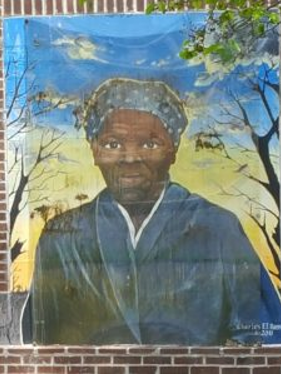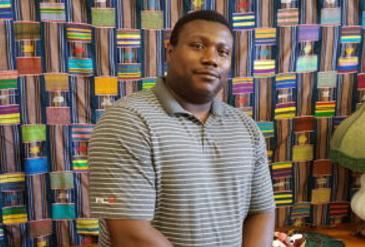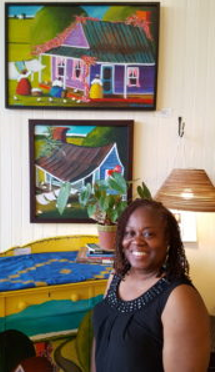By Michael H. Cottman
Urban News Service

“I never ran my train off the track, and I never lost a passenger.”
–Harriet Tubman
CAMBRIDGE, Maryland — Joe Manokey stood along a stretch of the Underground Railroad and spoke proudly about his legendary distant cousin, Harriet Tubman.
“Our family has always pushed to get Harriet Tubman more recognition,” said Manokey, 45, who was born in Dorchester County where Tubman became a famous abolitionist. “The Moses of Her People” helped more than 70 families and friends escape slavery through her Underground Railroad.
“Harriet Tubman led black people to freedom, but she was also a spy for the Union Army, a nurse, a cook and a scout,” Manokey said.
“She is an important part of history,” said Manokey. “And she is important to me as a member of my family.”
Manokey pointed to a walkway on the Harriet Tubman Underground Railroad Byway, a 125-mile driving tour across Dorchester and Caroline counties, dotted with 35 historical sites.
Manokey said that his family is honored that Tubman’s image soon will appear on the $20 bill.
Treasury Secretary Jack Lew announced in April that Tubman would replace slave owner Andrew Jackson on the $20 bill. This would make Tubman the first woman in more than a century — and the first African-American woman — to appear on U.S. paper currency.
The revised bill’s 2020 arrival will coincide with the centennial of women’s suffrage.
But not everyone is cheering. U.S. Rep. Steve King (R–Iowa) tried to block Treasury’s plan, but the Republican-led House Rules Committee killed his measure on June 21.

King’s office did not respond to repeated requests to explain his opposition to the Tubman $20.
“It’s not about Harriet Tubman, it’s about keeping the picture on the $20,” King said to Politico website. “Why would you want to change that? I am a conservative. I like to keep what we have.”
“This is a divisive proposal on the part of the president, and mine’s unifying,” King said. “It says just don’t change anything.”
The Treasury has no cost estimate for the Tubman $20, saying the expense will depend largely on security improvements and new accessibility features for the visually impaired.
Inspiration
Meanwhile, Cambridge resident Adrian Holmes — a co-owner of Liv Again, an upscale store featuring diverse art, novel furniture and home décor — said Tubman inspires women.

“Harriet Tubman being featured on the $20 bill makes her more attainable,” Holmes said. “She’s not a mystery woman from the past. Everywhere she went, she made a difference. Everywhere she went, she impacted her community, and that is inspiring.”
The road to Emancipation is well documented. Driving through Dorchester County on the Eastern Shore, tourists can visit the 17-acre Harriet Tubman Underground Railroad State Park and Visitor Center. The grand opening, next March 10, will unveil a memorial garden, walking paths and more.
The Byway’s 35 marked sites include Long Wharf in Cambridge, where slave ships offloaded enslaved black people who were sold along the waterfront; Malone’s Church in Madison, where free and enslaved black people gathered; and Joseph Stewart’s Canal, where enslaved blacks dug a seven-mile canal through the thick marsh on Taylors Island between 1810 and 1832. These enslaved Africans were the property of the affluent Stewart family. Tubman toiled in Joseph Stewart’s home and fields.
Though they celebrate Tubman’s profound contributions to America, many black residents in Cambridge say an undercurrent of racial tension has festered for decades along Maryland’s scenic, slow-and-easy Eastern Shore.
Fortitude

Jermaine Anderson, 42, co-owner of Liv Again, wants Tubman’s new-found national recognition to encourage more openness among Cambridge residents.
“I’m hoping it will spark a discussion about race relations here,” said Anderson, who grew up in Cambridge.
“Cambridge is a racially divided city, and the Harriet Tubman Park and the Tubman $20 bill present a better opportunity to talk about race.”
Cambridge has a long history of racial friction. Black residents protested against discrimination and advocated for civil rights. The city suffered race riots in 1963 and ‘67. Buildings burned, shots rang out and blacks clashed with police. Then-U.S. Attorney General Robert F. Kennedy invited Cambridge community leaders, both black and white, to Washington, D.C. in 1963 to stop the violence.
Meanwhile, Donald Pinder, president of the Harriet Tubman Organization, Inc., said Tubman’s museum in Cambridge is a testament to her fortitude.
Asked if the recent Tubman publicity will encourage Dorchester County to engage in candid discussions about race relations, Pinder paused.
“What people will say publicly is different from what people will say privately,” Pinder said. “Sometimes the truth never com




